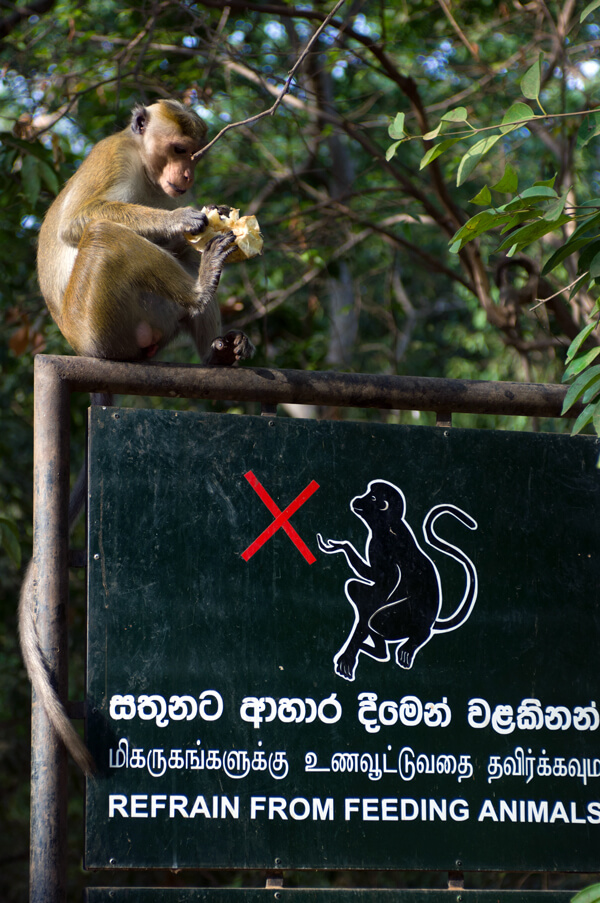Tourists headed abroad may rightly worry about their risk of catching nasty tropical diseases such as malaria and yellow fever. But they should also be concerned about the diseases they bring with them and how those may harm local wildlife, says anthropologist Michael Muehlenbein of Baylor University in Waco, Texas.
In the 2016 Annual Review of Anthropology, Muehlenbein explores what epidemiologists know about this two-way trade in diseases. He spoke with Knowable about the risks of ecotourists leaving something much more than footprints.
This conversation has been edited for length and clarity.
What got you interested in studying how ecotourism affects the health of wild animals?
I trained in public health before going into biological anthropology, and I’ve always wanted to combine tools from these different disciplines. I met a veterinarian who wanted to look at the health of orangutans in Sabah, the northernmost state of Malaysian Borneo, in the face of changing environment, in particular the expansion of oil palm plantations. He probably didn’t think I was going to take him up on his offer, but shortly after, I planned my first trip to Borneo.
I started working at Sepilok, one of the largest orangutan rehabilitation centers in the world. There were a lot of tourists, with the potential to bring diseases with them. I wanted to try to figure out what the risks were.
How do you study this?
I’ve conducted thousands of interviews with travelers at wildlife sanctuaries in Gibraltar, Saint Kitts, Japan, Malaysia and South Africa. We just got back from a monthlong trip to Thailand in which we extended it to elephant sanctuaries. We ask visitors about their current disease symptoms, vaccination status, environmental awareness. We ask their opinions about touching wild animals, how close they should get to wild animals, willingness to own one as a pet. In Sabah, we did throat swabs, and we found that over 6 percent of visitors have active respiratory-tract viruses in their throat.
Although more than half of the tourists surveyed at locations around the world were aware that they could potentially infect a primate with a disease, or become infected, many people still said they would touch or feed a wild animal if they could.
Is that a problem?
A cold to us is mild. A cold to an ape is life-threatening. Measles, chicken pox: life-threatening in these animals. Herpes viruses, too — a cold sore from humans can kill apes. Large portions of the population can be wiped out. And we really only see the major effects. There are probably a lot of individual cases that are not picked up.
When you work with primates in captivity, you gown up and put a mask on. It’s not just to protect you, it’s to protect them. But for decades, we’ve been walking into the forest with these animals and taking no precautions.
Are primates at special risk?
They’re genetically closely related, so we share a lot of pathogens with them, and they’re immunologically naïve to our diseases. They are mostly social animals, with a few exceptions, so if a pathogen gets into their population it can spread easily. And all of them have very protracted reproductive cycles. It takes a long time for them to grow up and have babies, and that means lower birth rates, longer maturation times. You can decimate a population of primates quickly, and it takes a long time to rebound.
But now we’re looking at it in elephants. They can get our tuberculosis and probably our herpes viruses.
Why focus on tourists? Have they been proven to transmit disease to wild animals?
Not yet, but that’s just because we haven’t been looking for it with the appropriate genetic epidemiological methods. It’s very difficult to document this with 100 percent certainty. But imagine an area where you’ve got hundreds of thousands of new people coming in all the time, and compare that to an area that just has a few hundred local people around. There is more opportunity for transmission from tourists, I think.
Plus, when you’re traveling, you’re seeking out experiences that are not part of your normal routine. From work in travel medicine, we know that travelers often disregard health advice. They eat salad and drink tap water. They are more willing to overconsume alcohol and have unprotected sex.
And many of them are also willing to touch wild animals, even when they know they’re not supposed to?
Constantly. I was just in South Africa last week, and I visited Table Mountain, home to the rock hyrax, a small thing that looks like a rodent. There are signs everywhere saying please do not feed them or touch them, and right in front of these, largely unenforced by staff, you see the tourists petting them and feeding them. I’ve documented this in probably 20 different locations now in regards to monkeys. It happens all over the world, even in places where supposedly the rules exist and supposedly are enforced.

“Don’t feed the animals”? It’s not easy for visitors to resist when the animals are cute and furry like these rock hyraxes on Table Mountain in South Africa. Despite official rules against feeding or touching animals, many wildlife parks have lax enforcement.
CREDIT: GREG BALFOUR EVANS / ALAMY STOCK PHOTO
When I ask tourists, “Do you think you can give diseases to these animals?” the answer is almost always yes. When asked to give examples, they typically write influenza. But if I also ask, would you still touch one if you’re given a chance, many still say yes — over 50 percent in some populations. And that is where we can identify this psychological disconnect, in which your knowledge about the risks comes second place to your desire to go ahead and break the rules, even knowing there are risks involved. Imagine you’ve spent $2,000 to go to Malaysia to see the orangutans and you’ve got a cold. Are you going to stay away? It becomes a complex moral question: How much do you respect the life of other animals over your vacation experience?
Why this urge to touch the animals?
It stems from biophilia, the desire to emotionally affiliate with nature. And it translates to touch because that was really our first form of communication, the way we explore our environment from day one. For wild primates in particular, it’s also because they’re cute. They’ve got hands like us. They play like us. One of the things that keeps coming up in interviews is that people have seen others do it and get away with it, so they think they can as well.
Does ecotourism pose other risks as well?
Absolutely. You’ve got the potential for introduction of invasive species. You have general degradation of the environment — look at safaris and the impact of off-roading on soil erosion. You’ve got problems with waste disposal in a lot of them. And some animals get chronically stressed, especially if they have no place else to go. It can significantly affect their stress physiology and, in turn, their reproductive abilities. A great example of added stress is iguanas on the Galapagos Islands.
You’ve also got the displacement of indigenous peoples in certain places and the use of local resources to develop and build these experiences. A lot of them are run by large, nonlocal corporations. The purpose of ecotourism — and the definition of it, technically — is that it’s run locally and done specifically to support local human communities and to raise awareness and finances for conservation efforts. I would argue that a majority of things that claim to be an ecotourist experience do not fit that definition. They’re calling it ecofriendly when it’s actually not. Some of us use the term greenwash.

Native to Sri Lanka, the toque macaque (Macaca sinica) is listed as endangered by the International Union for Conservation of Nature. Here, one enjoys its own meal atop a sign warning visitors to keep their food to themselves in Polonnaruwa, a popular tourist destination in the country.
CREDIT: STEVE DAVEY PHOTOGRAPHY / ALAMY STOCK PHOTO
This doesn’t sound good for ecotourism. Is it as bad as it sounds?
I’m not saying that nature-based tourism is evil. I’m just saying there are some risks that we have to account for. In large part it requires physical separation between humans and nonhuman animals — and enforcement of it. It doesn’t mean building walls. It just means stop touching.
There are certainly places that have got it right, that have regulations and enforce them. If you want to go visit the mountain gorillas in Rwanda, there are safety briefings. You have to keep a certain distance, and if you’re known to be sick you can’t go. I respect what they do there tremendously. But in a lot of other places, the regulations are not enforced. And you can imagine that’s especially true of operations where guides depend on tips. I don’t know where the balance is between those two groups.
How can people tell good operations from bad ones?
You can do your research online, see what other people have to say about these groups. But first and foremost, it is your responsibility to act in a certain way. Don’t touch the animals. Speak up when you see other people breaking the rules. I’ve done this and sometimes I’ve pissed some people off. If I see someone with a monkey on their back, and they’re feeding it, I’m the type of person who says that’s against the regulations, and you’re going to get bit. At least tell local authorities that these things are happening and they’re inappropriate.
Show respect and responsibility when you visit — not just to the environment and the animals, but to the people you encounter. If we’re going to invest time, money and effort into anything, it needs to be there. It is a social responsibility, and we need to frame it as such — it’s a responsibility to yourself, to others and to other species.




